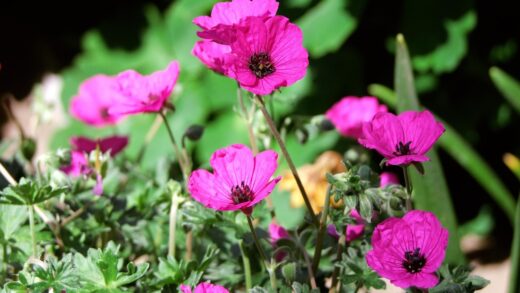The gerbera, this perennial plant originating from South Africa and belonging to the Asteraceae family, has captured the hearts of many garden enthusiasts with its vibrant, daisy-like flowers. Although often treated as an annual in our climate, it can be successfully overwintered with the right conditions, allowing us to enjoy its floral splendour again the following season. Overwintering not only means saving the plant but also provides an opportunity for it to develop stronger, lusher clumps year after year, which will reward your care with even more abundant blooms. The key to successful overwintering lies in a thorough understanding of the plant’s needs, proper timing, and careful preparation.
Species and cultivars of Gerbera×hybrida are sensitive to frost, making their overwintering ઉત્પાદન открытом in most gardens risky, if not impossible. For potted specimens, however, the situation is considerably simpler, as they can easily be moved to a sheltered location. It is important to note that during overwintering, the plant enters a dormant state, so its care requirements also change significantly. Ignoring this can easily lead to the plant’s demise, so it is worthwhile to prepare thoroughly for this period.
The Importance of Autumn Preparations
The success of overwintering gerberas largely depends on autumn preparations. Before the temperature consistently drops below 10 degrees Celsius (50 degrees Fahrenheit), but still before the first serious frosts, you need to start preparing the plant for the cold months. This is usually around late September or early October, but current weather conditions should always be taken into account. One of the most crucial steps is pruning the plant; carefully remove dried leaves and flower stalks to prevent the development and spread of fungal diseases. It’s also advisable to remove some green, healthy leaves, especially the outer, older ones, so the plant can direct its energy towards strengthening its roots and crown.
During preparation, pay special attention to detecting pests and diseases. Thoroughly inspect the leaves, especially their undersides, and the stems for any signs of aphids, spider mites, or other pests. If you notice an infestation, treat the plant with an appropriate, preferably biological, pesticide before bringing it indoors for overwintering. Fungal diseases, such as powdery mildew or grey mould, can also cause serious problems during overwintering, so act immediately if you see such symptoms. A healthy, strong plant will survive the winter period much better than a weakened, diseased one.
For potted gerberas, repotting can also be considered in the autumn, especially if the plant has outgrown its pot or the soil is depleted. Choose a loose, well-draining potting mix and a pot that is only one size larger than the previous one. After repotting, water the plant moderately. It is important that the root neck is not planted deeper than it was originally, as this can lead to rot. Repotting is stressful for the plant, so it is advisable to do this at least a few weeks before the colder weather sets in, to give it time to recover.
More articles on this topic
In the final weeks before bringing the plant indoors for good, gradually reduce the amount of watering. This helps the plant prepare for its dormant period and reduces the risk of root rot in the cooler, more humid environment. Stop fertilising completely during this time, as growth slows down, and excess nutrients would only accumulate in the soil, potentially harming the roots. Ensuring a gradual transition is key for the plant to adapt to the changed conditions.
Choosing the Ideal Overwintering Location
One of the most important conditions for successfully overwintering gerberas is choosing the right overwintering location. The ideal place is bright, cool, and frost-free. The optimal temperature during overwintering is between 5-10 degrees Celsius (41-50 degrees Fahrenheit). In a warmer place, the plant may not enter dormancy properly or may start to sprout prematurely, which can weaken it. Temperatures below freezing can be fatal. It is important that the room is well-ventilated to prevent condensation and the development of fungal diseases.
Excellent overwintering locations can include an unheated or only slightly heated conservatory, a bright staircase, a frost-free garage with a window, or even a cool cellar, provided there is adequate light and ventilation. Dark rooms are not suitable for overwintering gerberas because the plant needs some light even during its dormant period, albeit 은행잎. If natural light is scarce, you can supplement with a grow light, but be careful that the lamp does not produce too much heat. Direct, strong sunlight should be avoided during overwintering.
Another important factor when choosing a location is air humidity. A too-humid environment encourages fungal diseases, while too-dry air can lead to leaf desiccation and the proliferation of pests like spider mites. The ideal air humidity is around 50-60%. If the air is too dry, you can occasionally spray the plant’s surroundings with water or place a tray filled with water and pebbles under the pot to increase humidity. Good air circulation also helps regulate humidity and prevent diseases.
More articles on this topic
Before finally placing the plants in their overwintering spot, it is advisable to thoroughly clean and disinfect the area to reduce the chances of pathogens and pests overwintering. Check for any draughty gaps where cold air could enter and harm the plants. Do not place pots directly on a cold floor; use saucers or shelves to insulate them from the ground cold. A carefully chosen and prepared overwintering location greatly contributes to your gerberas surviving the winter здоровыми.
Care During the Winter Dormancy Period
During the winter months, the gerbera enters a dormant state, its metabolism slows down, and thus its care requirements change significantly. The most important task during this period is to establish a proper watering regime. Overwatering is the most common mistake that can lead to the plant’s demise, as roots can easily rot in a cold, wet substrate. Water only when the top layer of soil is completely dry, and even then, only moderately, giving just enough water so that the root ball does not dry out completely. It is better to water less frequently and with less water than too often and too much.
Fertilising should be completely stopped during overwintering. Since the plant is not actively growing, it does not need extra nutrients. Excessively applied nutrients can accumulate in the soil and damage the roots or promote salt build-up on the pot’s surface. Fertilising should only be resumed in spring, at the beginning of the growing season, when the plant is actively sprouting. During the winter months, rest is paramount, not stimulating growth.
Regularly inspect the plants during overwintering to detect any potential problems early. Pay attention to the condition of the leaves: yellowing, browning, or wilting can indicate watering errors, lack of light, or disease. Examine the plant for pests such as spider mites or mealybugs, which can easily multiply in drier overwintering locations. If you notice a problem, take the necessary steps immediately, such as adjusting watering or applying an appropriate pesticide.
Ventilating the overwintering room is also an important part of winter care. Occasionally, on milder, frost-free days, open a window to allow fresh air to circulate and reduce humidity. Be careful not to place plants in a direct draught, as this can harm them. Proper air exchange helps prevent fungal diseases, such as grey mould, which spread easily in stagnant, damp air. Careful attention and minimal but expert intervention will ensure that the gerbera successfully weathers its dormant period.
Diseases and Pests During Overwintering
During overwintering, even with the most careful preparations, certain diseases and pests can appear. Weakened plants, as well as suboptimal overwintering conditions – such as high humidity, poor ventilation, or incorrect temperature – favour their occurrence. One of the most common problems is fungal diseases, especially grey mould (Botrytis cinerea) and powdery mildew. Grey mould forms a grey, velvety coating on plant parts, especially where there are injuries or where air cannot circulate properly. Powdery mildew, on the other hand, creates a white, powdery layer on the leaves.
To prevent these fungal diseases, proper ventilation, avoiding overwatering, and immediate removal of dead plant parts are crucial. If an infection has already occurred, carefully remove the diseased parts and, if necessary, apply an appropriate fungicide. It is important to spray carefully and, if possible, temporarily isolate the treated plant from others to prevent the further spread of infection. Prevention is always more effective than treating an already established problem.
Among pests, spider mites and mealybugs can cause the most trouble during overwintering. Spider mites are tiny, spider-like creatures that suck sap from the undersides of leaves, spinning fine webs. Their presence can be indicated by yellowing, bronzing of leaves, and the appearance of tiny, light-coloured spots. Mealybugs form a white, cotton-like coating in the leaf axils and on the stems. Both pests prefer warm, dry air, so increasing the air humidity in the overwintering room and regular inspection can help prevent them.
If you notice a pest infestation, there are several solutions. For a mild infestation, it may be sufficient to wash the plants with lukewarm soapy water or remove the pests with a cotton swab dipped in alcohol. In more stubborn cases, an insecticide may be necessary; choose one that can be safely used indoors and is less harmful to the environment. Regularity and persistence are also important in the fight against pests to get rid of them completely before they cause serious damage to the plant.
Spring Awakening and Acclimatisation to Outdoor Conditions
As spring approaches, the days lengthen, and temperatures begin to rise, it is time to prepare your gerberas for their return outdoors. This process should not be rushed; plants must be gradually acclimatised to the changed conditions. Usually, late March or early April is when you can start the “awakening,” but always consider the current weather and the end of frost danger. Initially, you can increase the amount of watering and also start with light fertilising to stimulate growth.
The first step in acclimatising to outdoor conditions is to take the plants out during the day, in mild, sheltered weather, to a shady or semi-shady spot. Initially, leave them out for only a few hours, then gradually increase the time spent outdoors. It is important not to expose the plants immediately to strong, direct sunlight, as their leaves have become sensitive during overwintering and can easily burn. Until the night frosts have passed, be sure to bring them back to their sheltered overwintering place at night. This gradual acclimatisation helps the plant adapt to outdoor light conditions, temperature fluctuations, and air movement.
When there is no longer a danger of frost and the plants have become accustomed to outdoor conditions, you can permanently move them outdoors. This is usually around mid-May. Before planting out, it may be advisable to repot the plants into fresh, nutrient-rich potting soil, especially if this was not done in the autumn. Choose a sunny spot, but one that is slightly protected from the strong midday sun. Gerberas love a lot of light, but too much direct sunlight can damage their leaves. Well-drained soil remains crucial for their successful cultivation.
After moving them outdoors, continue regular watering and fertilising according to the needs of the growing season. The gerbera will be grateful for the care and will soon bloom again, decorating your garden or balcony. Successfully overwintered plants that are carefully restarted in spring are usually stronger, more resilient, and bloom more abundantly than newly purchased seedlings. Therefore, overwintering not only means saving the plant but is also a kind of investment in the floral splendour of the coming year.
Common Mistakes in Overwintering Gerberas
During gerbera overwintering, numerous pitfalls can lead to the plant weakening or even dying. One of the most common mistakes is overwatering during the dormant period. Many people tend to continue watering as they did during the growing season, ignoring the fact that the plant’s metabolism has slowed down and its water uptake has significantly decreased. Cold, stagnant water causes root rot, which almost certainly leads to the plant’s death. Always wait until the top layer of soil is dry before adding a small amount of water.
Another frequent problem is an unsuitable overwintering temperature. If the room is too warm, the plant cannot enter dormancy properly and may start to sprout prematurely, which exhausts it. If it is too cold and the temperature drops below freezing, the plant can freeze. Ensuring an ideal temperature between 5-10 degrees Celsius (41-50 degrees Fahrenheit) is essential. Additionally, lack of light can also cause problems; although the plant is dormant, it needs a minimal amount of light to maintain its life processes. Gerberas overwintered in a completely dark place often weaken and become more susceptible to diseases.
Ignoring pests and diseases can also have serious consequences. Plants brought in for overwintering must be thoroughly inspected and, if necessary, treated before being brought indoors. They should also be regularly checked during overwintering because the enclosed, sometimes humid environment can favour the proliferation of certain pathogens and pests. A problem detected in time is easier to solve than an advanced infestation. Particular attention should be paid to grey mould and spider mites.
Finally, rushing the spring acclimatisation to outdoor conditions is also a common mistake. Plants suddenly moved from their overwintering spot into strong sun or cold weather experience stress, their leaves can burn, or they can be damaged by the sudden temperature change. The principle of gradualness is extremely important here: slowly, over several days or weeks, accustom the plant to outdoor conditions before permanently moving it out. By avoiding these mistakes and considering the plant’s needs, overwintering gerberas can be successful, and you can enjoy your favourite flowers year after year.

















